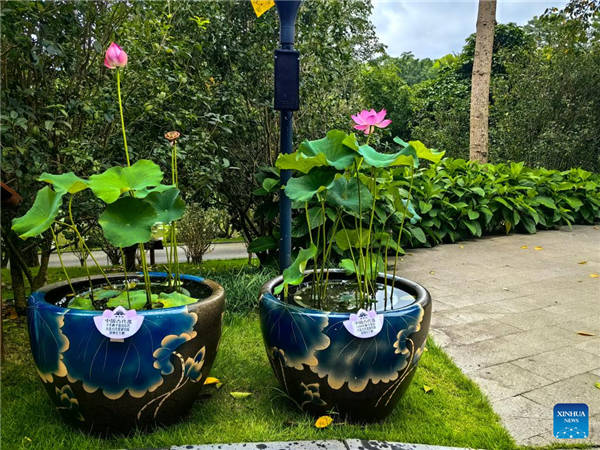
Lotuses growing from ancient seeds are displayed at the Nanning botanical garden in Nanning, south China's Guangxi Zhuang Autonomous Region, June 18, 2024. (Xinhua)
After lying buried for 1,200 years, a lotus seed has grown into a blooming flower in a southern Chinese city, revealing the ancient appearance of a flower that has featured prominently in Chinese poetry and cuisine.
The lotus, displayed at the Nanning botanical garden in Nanning, capital of Guangxi Zhuang Autonomous Region, grew from one of the three seeds excavated from northeast China's Liaoning Province. Carbon-14 tests have identified them as around 1,200 years old.
Since May last year, botanists from the Guangxi research institute for subtropical plants have been attempting to revive the seeds. They carefully cut open the seed shells to facilitate sprouting before placing them in a carefully monitored environment. Eventually, two seeds sprouted, and one blossomed for the first time last month.
Lotus is a synonym for purity and integrity in traditional Chinese culture, with a Song Dynasty (960-1279) article lauding it for "rising unsullied from mud," while its seeds and roots are common ingredients in Chinese cuisine.
China has a long history of bringing centuries-old lotus seeds back to life. Ming Dynasty (1368-1644) records have documented the process of reviving petrified lotus seeds of unknown age.
More recent revivals of ancient lotus seeds often involved lab cultivation. In 2019, a lotus flower bloomed at the Old Summer Palace, or Yuanmingyuan, in Beijing, after scientists worked on its seed that had been underground for over 100 years.
Wei Miaoqin, researcher with the institute, said lotus seeds feature a multi-layered structure that seals off water and air. This allows them to remain dormant for over a millennium if kept in a dry, cool and sealed environment.
Resurrecting these ancient seeds has allowed people today to observe up close the ancient flowers, which feature fewer petals than their modern varieties, Wei said.
"It's like a time travel experience where we are looking at the same flower once appreciated by our ancestors," she added.

This photo taken on June 1, 2024 shows the blossom of a millennium-old lotus seed at the Nanning botanical garden in Nanning, south China's Guangxi Zhuang Autonomous Region. (Xinhua)

This photo taken on May 19, 2023 shows the millennium-old lotus seeds being revived by researchers at the Nanning botanical garden in Nanning, south China's Guangxi Zhuang Autonomous Region. (Xinhua)

- Lotus grown from millennium-old seed blossoms in Guangxi
- [@ASEAN] Nearly 100 Malaysian Participants Experience High-speed Railway Technology in Guangxi
- Vietnamese merchant's entrepreneurial spirit shines in Guangxi
- Sugar production in Guangxi accounts for about 60% of national output
- Guangxi sees 5,000th freight train on New International Land-Sea Trade Corridor
- Promotion show of tasty melons and fruits in Guangxi held in Nanning
Popular Videos
Hot comments
- China Life: Chinese women shine with She Power
- First apes at U.S. zoo receive COVID-19 vaccine made for animals, zoo official says
- Homemade curling videos trending in China
- Child sex offenders to be strictly punished
- 6-year-old Chinese boy becomes youngest Rubik's Cube player for A-level
- 16-year-old Chinese girl reaches summit of Mt. Qomolangma
- 2,700-yr-old cat paw-shaped ornaments a hit on Chinese social media
- China-made cotton-padded pantyhose sweep European market
- Asia is young!
- 86-year-old grandma in Hebei spends most her life on traditional cheongsam
Top Reviews
- Xi stresses improving systems for exercising full, rigorous Party governance
- Xi holds talks with Peruvian president
- Xi, Venezuela's Maduro exchange congratulations on 50th anniversary of ties
- China, Vietnam discuss strategic transport infrastructure cooperation
- China's Chang'e-6 collects 1,935.3 grams of samples from moon's far side
- China to raise duty-free limit for mainland visitors to HK, Macao
- Lotus grown from millennium-old seed blossoms in Guangxi
- Bloody Business — Unveiling the U.S. Military-Industrial Complex
- Bustling of hectic outdoors kept at bay in courtyards
- A truly exhilarating taste of tea and unity







